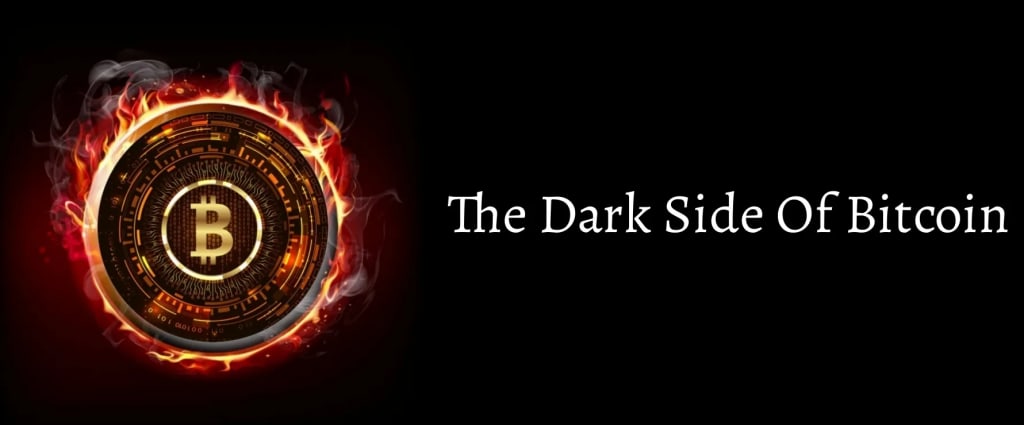
Bitcoin. A story of hope and betrayal.
In our exploration of Bitcoin’s history, we’ll delve into the events that have transpired since the inception of this disruptive financial technology in 2009, and examine how and why Bitcoin’s exponential adoption as person-to-person electronic cash halted.
I hope you find this information enlightening!
The Dark Side Of Bitcoin - A Documentary

The Story
By 2017, Bitcoin was on the verge of becoming a leading payment method used as digital cash in commerce, and it was only a matter of a few more years before achieving mass adoption.
Yet, Bitcoin wasn’t going to disrupt a multi-trillion-dollar business without facing fierce opposition.
Just like any other independent and disruptive technology, a plan had to be devised to halt the rise of Bitcoin by the powerful interests that felt the threat to their business.
Bitcoin, a decentralized network with no entity in control did not have any apparent vulnerabilities to exploit, but it had to be stopped nonetheless.
There had to be some form of control to tame the beast that was aiming to alter the balance of global power, the staggering force that empowered individuals no matter the region and social status, beliefs financial wealth, or other restrictions.
Bitcoin was empowering everyone, and this was the main concern.
By the end of 2010, Satoshi Nakamoto was already a ghost but he had already left a legacy to the early adopters that followed in his footsteps.
Satoshi left behind the whitepaper and directions on the course of the Bitcoin financial revolution, instructions that would place Bitcoin as a competitor next Visa, Mastercard, and PayPal. A new form of money that rendered Central Banks obsolete.
It is not difficult to assume why mainstream finance immediately identified a target in Bitcoin.
Exponential Adoption
In 2010, Wikileaks, in an unprecedented move, declared the adoption of Bitcoin for donations, after governments had cut its access to the banking system.
It was that time the system realized the threat this new and disruptive technology posed.
Business like usual was no more.
Bitcoin was nothing like any other threat they faced before, although the Peer-to-Peer file-sharing revolution was probably a lesson.
Nothing could shut down Bitcoin even at this early stage. They could cut off one head by seizing websites, but ten more heads would instantly appear.
When finance realized it was facing a fierce competitor expanding so rapidly that within just the next few years it would threaten the very foundations of its establishment, the plan to limit Bitcoin’s potential started taking effect.
However, you can’t ban or control a decentralized network and this was understood soon enough, so a different course of action was necessary.
And the only way was by making the network unusable on a massive scale. They had to block the rapid adoption, the waves of adoption that were mathematically leading to global acceptance of decentralized peer-to-peer electronic cash.
Bitcoin had one weakness.
With an update in late 2010, Satoshi applied a block limit of 1MB in size, as a method to avoid spam on the network.
This 1MB block size limit was supposed to be increased within a few years, yet that never happened.
Block The Stream
In June 2013, Adam Back made his official Bitcoin appearance with posts in the bitcointalk forum and immediately became a figure of authority in the Bitcoin community.
Back was mentioned in the Bitcoin whitepaper for Hashcash, a reference that extensively assisted him in his plans.
He immediately pointed out his view on the Bitcoin code and how his work with Hashcash had played a crucial role in the development of Bitcoin, even going so far as to declare Bitcoin “an extension of Hashcash”.
Right after his arrival, Adam Back together with Bitcoin Core developers founded Blockstream, a for-profit company aiming to secure funding for Bitcoin developers.
In retrospect, it appears the motives behind the creation of this company were different, as Core took over Bitcoin’s developments and forced out the previous developers of the Satoshi era in 2015.
Bitcoin was designed as a decentralized system that operates without the involvement of intermediaries or trusted third parties.
Yet, Blockstream was funded by the same foundations that constitute Bitcoin’s competition. AXA, Mastercard, banks, and payment processors.
A system of politics manipulating the money supply, generating inflation, raising taxes for offensive wars and geopolitics dominance is the system Bitcoin was terminating.
That same system funded Blockstream.
Control by Confusion
Most of the BTC maximalists are already confused on their own, therefore instruments of those in control of the narrative (Core/Blockstream).
“Because of the lack of clarity, people need to continue to look to that person to try to gauge if they’re going in the right direction.”
“They become dependent and off-balance, continuing to need to come back to that leader to interpret reality for them.
Continuing to confuse people can be a subtle but effective means of control.”
During the blocksize debate, supporters of small blocks were constantly sending out mixed messages to generate confusion and obfuscate true intentions.
[Insert tweet where Back says strongly agree 2MB now]
Gaslighting tactics were enforced with no intention of increasing the blocksize limit.
The responses and arguments by the BTC side entirely contradicted the whitepaper, Bitcoin fundamentals, and the original intention of peer-to-peer electronic cash.
Censorship
Propaganda is just one of the tactics Blockstream enforces.
Censorship is a second one. A practice so common within the BTC community that we encounter it daily.
Controlling the information is about controlling the narrative, with the ulterior motive to control developments and stagnate scaling progress.
Blockstream hijacked the project and ousted all devs that did not align with their version of Bitcoin like Gavin Andresen, Mike Hearn, and Jeff Garzik.
A free crypto press would have been detrimental to Blockstream’s plans, therefore, controlling the information was a significant part of the grand plan.
Blockstream found support from financial forces that had been entering Bitcoin since 2011, entities that were in possession of major cryptocurrency online news websites and magazines like Coindesk and Cointelegraph.
In 2015, the two of the most used sources of information about Bitcoin were the Reddit r-bitcoin community and the Bitcoin forum, bitcointalk. Surprisingly, both these Bitcoin communication channels were controlled by one anonymous person under the alias Theymos after Satoshi’s departure in 2010.
Both these Bitcoin forums initiated an information war with the initiation of a digital crusade against big blockers.
On Reddit, Theymos was banning people from participating in discussions if they didn’t align with his position, while, on bitcointalk, accounts supporting bigger blocks were red-flagged and deemed not to be trusted.
With the help of Theymos, Blockstream managed to obliterate any opposition, censor debates, and create a cult of BTC supporters with religious devotion and military discipline.
Ad hominem is still a common practice by the BTC maximalists noticeable everywhere.
Anyone asking questions will meet either censorship or the fury of a mob of angry keyboard warriors who use a toxic approach as their main line of defense, thinking this approach will assist their goals, which is always about the price of BTC.
The price was the only reason they were in Bitcoin anyway, yet ignorance of the disruptive fundamentals of Bitcoin will be the downfall of the BTC version.
All these facts lead us to understand the reasons Core/Blockstream surrendered Bitcoin to the banks.
Custodial Lightning
Who is using Bitcoin today, in which way, and what plans are there for the future?
Is El Salvador a successful example?
Even by forcing the acceptance of Bitcoin through the Lightning Network, no adoption is visible in El Salvador.
Lightning is not a viable solution. The only way the end user can use the Lightning Network is through custodial wallets ( custodial and KYC-compliant LN wallets), that already dominate transactions (Strike, Chivo, Wallet of Satoshi, Bitcoin Beach, etc).
When was it that Satoshi suggested Bitcoin would require trusted third parties to control the transactions?
The whitepaper specifically explains how Bitcoin renders all trusted third parties obsolete. Yet, it is the maximalists that brought them all back.
All custodial wallets are censorable. They can freeze any amount and exclude any individual from the financial system.
How is this supposed to be providing censorship resistance and a response to the failures of the banks?
Decentralization secures a tamper-proof network and transactional censorship resistance.
Yet, with the BTC version of Bitcoin, censorship resistance becomes a luxury only a few can afford. Why do maximalists promote that everyone should run their own node while Satoshi never intended this?
The reason is to choke the network and make it unusable with a low blocksize limit forcing high fees, aiming to reduce Bitcoin’s disruptive monetary potential.
Bitcoin in the BTC version is opposing financial freedom. Under Blockstream, Bitcoin is submitted to the banking system.
Saylor suggests that we should not upset the banks and BTC maximalists cheer.
We watch modern Bitcoin thought leaders telling us how Bitcoin was never about payments, never a cryptocurrency, never aimed for mass adoption as P2P Cash, and was not for the people who live with less than $2 per day.
Bitcoin’s rapid adoption was halted. It was rendered unusable on a massive scale with bottlenecks like RBF, 1MB limit, SegWit, LN, and custodial mechanisms that stripped it of its revolutionary principles.
Custodial Lightning is not Bitcoin and Lightning is unable to scale either without a larger blocksize limit which is 133MB per the Lightning Whitepaper.
Users of custodial LN services don’t have access to private keys.
Financial hubs are already controlling the Lightning Network.
Furthermore, running an LN node is impractical, as high on-chain fees do not allow opening and closing channels.
Custodial Lightning does not allow extracting private keys and will soon demand full KYC.
Therefore, LN is no different from using a mobile bank application or PayPal, yet, even these apps are more efficient and user-friendly today than Lightning.
Saylor promotes regulations, KYC/AML compliance, and custodial wallets, and the BTC fans are cheering, waiting for one more price pump by institutional liquidity disregarding the dire situation Bitcoin has entered.
In Conclusion
The global financial system is mired in stagnation.
Inefficient legacy systems have been burdening the world’s economies for decades with unnecessary bureaucracy, complexity, and risk.
The same system is now in control of Bitcoin, having reversed adoption and diverted the project from its original purpose.
The dominant version of Bitcoin deviated from its original purpose of challenging the inefficient and corrupt legacy financial system and ended up becoming a part of it.
We are bringing disruption to the very fundamentals of finance by challenging the status quo and promoting the true essence of peer-to-peer electronic Cash with low fees and near-instant transactions.
We aim to create a borderless and permissionless economy where everyone can participate and benefit, regardless of their location or socioeconomic background.
We believe that by empowering individuals with control over their own finances, we can create a more equitable and transparent financial system for all.

Originally Published on Medium
👉 Follow me on X.com
👉 LinkTree: @PanteraBCH
Don’t forget to Subscribe and Like if you enjoyed this article!







Comments
There are no comments for this story
Be the first to respond and start the conversation.